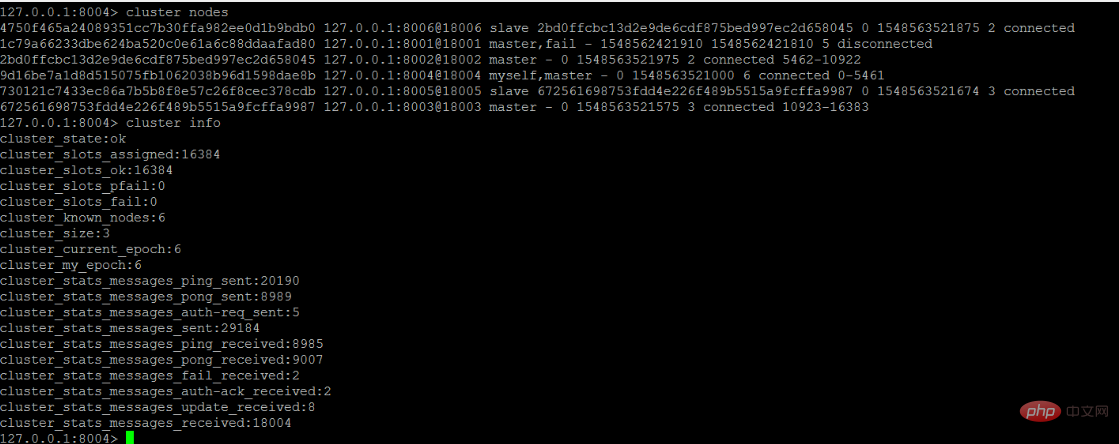How to detect faults in Redis cluster?
Method for fault detection in Redis cluster: first modify the Python script and write a piece of data every 1 second; then write data to the Redis cluster in a loop, and forcefully kill a master node to observe the application connection situation; Finally, restart the downed 8001 node.

Method for fault detection in Redis cluster: automatic failover test
Modify the Python script and write every 1s The purpose of entering a piece of data is to facilitate observation of the impact on the application within the time period (about 1 second) when the master node goes down and the cluster automatically fails over, or the performance of the application before and after automatic failover.
The following script writes data to the Redis cluster in a loop. During execution, it forcibly kills a master node and observes the application connection status.
At the same time, if an exception occurs, suspend the application for 2s, because the cluster failover time configured above is 1s. If the application is suspended for 2s, the failover process can be skipped. When the failover is completed, the application It returned to normal state. Although node 8001 was down, the application continued to connect to node 8001, but the application was completely unaware.
Related learning recommendations: redis video tutorial
import timefrom time import ctime,sleepfrom rediscluster import StrictRedisCluster
startup_nodes = [
{"host":"111.231.253.***", "port":8001},
{"host":"111.231.253.***", "port":8002},
{"host":"111.231.253.***", "port":8003},
{"host":"111.231.253.***", "port":8004},
{"host":"111.231.253.***", "port":8005},
{"host":"111.231.253.***", "port":8006}
]
redis_conn= StrictRedisCluster(startup_nodes=startup_nodes, decode_responses=True,password="root")for i in range(0, 100000): try:
redis_conn.set('name' + str(i), str(i)) print('setting name' + str(i) +"--->" + time.strftime('%Y-%m-%d %H:%M:%S',time.localtime(time.time())))
time.sleep(1) except: print("connect to redis cluster error")
time.sleep(2)It was found that after killing the master node, only one connection error occurred, and then because of Redis The automatic failover of the cluster is successful and transparent to the program, so the application then works normally and is not affected by the failure of one of the master nodes.

The status of the cluster at this time is that node 8001 is down. Obviously, the slave node 8004 corresponding to 8001 takes over the master node, upgrades to master, and provides services to the outside world

Observe the logs of the 8004 instance that was upgraded to the master node. You will find that after the original 8001 master node is forcibly killed, within 1 second, 8001 is successfully upgraded to the master node.
If During the failover process, no application accesses Redis, and the application does not even know that a failover has occurred in the Redis cluster. As long as the master and slave nodes of a certain node in the cluster do not go down at the same time, there will be no problem in the entire cluster, and it will not affect the application. The process is completely transparent.

Then restart the downed 8001 node, and you will find that the 8001 node automatically becomes the slave node of its original slave node (8004)

The above is the detailed content of How to detect faults in Redis cluster?. For more information, please follow other related articles on the PHP Chinese website!

Hot AI Tools

Undresser.AI Undress
AI-powered app for creating realistic nude photos

AI Clothes Remover
Online AI tool for removing clothes from photos.

Undress AI Tool
Undress images for free

Clothoff.io
AI clothes remover

Video Face Swap
Swap faces in any video effortlessly with our completely free AI face swap tool!

Hot Article

Hot Tools

Notepad++7.3.1
Easy-to-use and free code editor

SublimeText3 Chinese version
Chinese version, very easy to use

Zend Studio 13.0.1
Powerful PHP integrated development environment

Dreamweaver CS6
Visual web development tools

SublimeText3 Mac version
God-level code editing software (SublimeText3)

Hot Topics
 1386
1386
 52
52
 How to build the redis cluster mode
Apr 10, 2025 pm 10:15 PM
How to build the redis cluster mode
Apr 10, 2025 pm 10:15 PM
Redis cluster mode deploys Redis instances to multiple servers through sharding, improving scalability and availability. The construction steps are as follows: Create odd Redis instances with different ports; Create 3 sentinel instances, monitor Redis instances and failover; configure sentinel configuration files, add monitoring Redis instance information and failover settings; configure Redis instance configuration files, enable cluster mode and specify the cluster information file path; create nodes.conf file, containing information of each Redis instance; start the cluster, execute the create command to create a cluster and specify the number of replicas; log in to the cluster to execute the CLUSTER INFO command to verify the cluster status; make
 How to clear redis data
Apr 10, 2025 pm 10:06 PM
How to clear redis data
Apr 10, 2025 pm 10:06 PM
How to clear Redis data: Use the FLUSHALL command to clear all key values. Use the FLUSHDB command to clear the key value of the currently selected database. Use SELECT to switch databases, and then use FLUSHDB to clear multiple databases. Use the DEL command to delete a specific key. Use the redis-cli tool to clear the data.
 How to read redis queue
Apr 10, 2025 pm 10:12 PM
How to read redis queue
Apr 10, 2025 pm 10:12 PM
To read a queue from Redis, you need to get the queue name, read the elements using the LPOP command, and process the empty queue. The specific steps are as follows: Get the queue name: name it with the prefix of "queue:" such as "queue:my-queue". Use the LPOP command: Eject the element from the head of the queue and return its value, such as LPOP queue:my-queue. Processing empty queues: If the queue is empty, LPOP returns nil, and you can check whether the queue exists before reading the element.
 How to use the redis command
Apr 10, 2025 pm 08:45 PM
How to use the redis command
Apr 10, 2025 pm 08:45 PM
Using the Redis directive requires the following steps: Open the Redis client. Enter the command (verb key value). Provides the required parameters (varies from instruction to instruction). Press Enter to execute the command. Redis returns a response indicating the result of the operation (usually OK or -ERR).
 How to use redis lock
Apr 10, 2025 pm 08:39 PM
How to use redis lock
Apr 10, 2025 pm 08:39 PM
Using Redis to lock operations requires obtaining the lock through the SETNX command, and then using the EXPIRE command to set the expiration time. The specific steps are: (1) Use the SETNX command to try to set a key-value pair; (2) Use the EXPIRE command to set the expiration time for the lock; (3) Use the DEL command to delete the lock when the lock is no longer needed.
 How to read the source code of redis
Apr 10, 2025 pm 08:27 PM
How to read the source code of redis
Apr 10, 2025 pm 08:27 PM
The best way to understand Redis source code is to go step by step: get familiar with the basics of Redis. Select a specific module or function as the starting point. Start with the entry point of the module or function and view the code line by line. View the code through the function call chain. Be familiar with the underlying data structures used by Redis. Identify the algorithm used by Redis.
 How to make message middleware for redis
Apr 10, 2025 pm 07:51 PM
How to make message middleware for redis
Apr 10, 2025 pm 07:51 PM
Redis, as a message middleware, supports production-consumption models, can persist messages and ensure reliable delivery. Using Redis as the message middleware enables low latency, reliable and scalable messaging.
 How to start the server with redis
Apr 10, 2025 pm 08:12 PM
How to start the server with redis
Apr 10, 2025 pm 08:12 PM
The steps to start a Redis server include: Install Redis according to the operating system. Start the Redis service via redis-server (Linux/macOS) or redis-server.exe (Windows). Use the redis-cli ping (Linux/macOS) or redis-cli.exe ping (Windows) command to check the service status. Use a Redis client, such as redis-cli, Python, or Node.js, to access the server.




